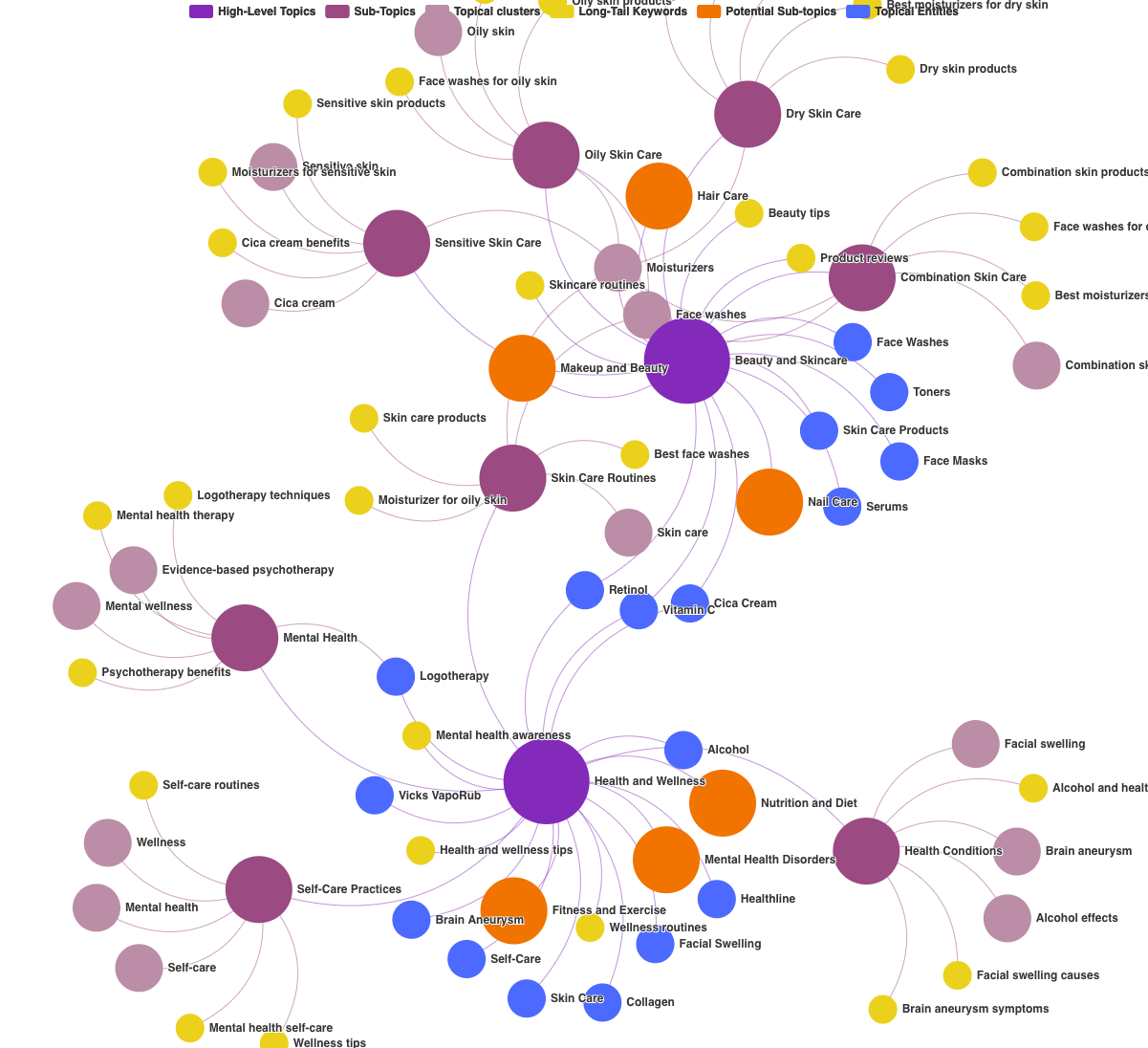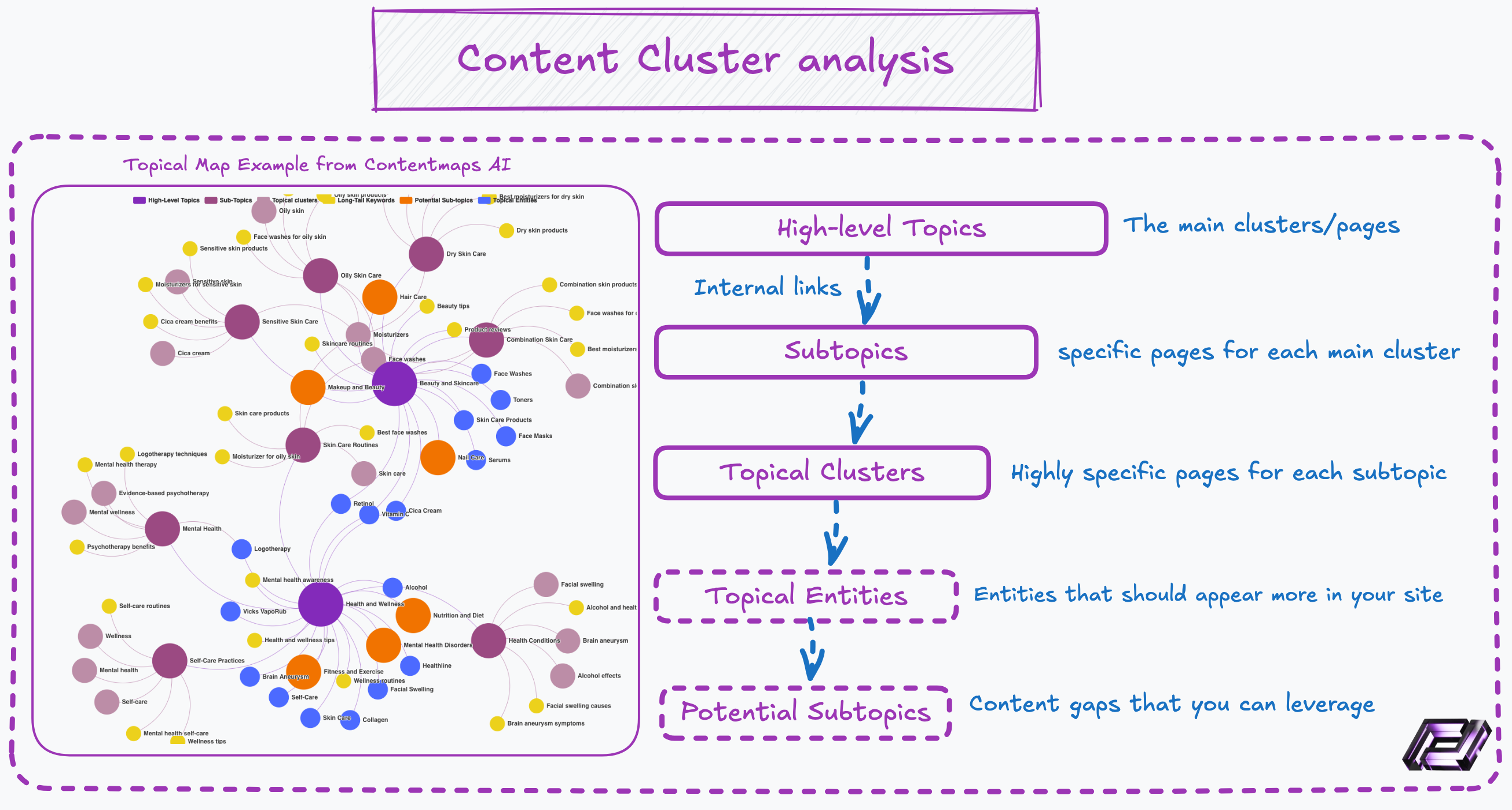Docs
Understanding SEO Topical Maps and Content Clusters
Let's dive deep into understanding topical maps and how they visually represent content clusters.
This particular example showcases a content cluster analysis for a website likely focused on health, beauty, and wellness, potentially for a company like Contentgeeks AI.
Deconstructing the Topical Map

This map is cleverly organized into a hierarchical structure, making it easy to understand the relationships between different levels of content:
- High-Level Topics (Purple): These are the broadest categories, the core themes around which your entire content strategy revolves. In this example, we see "City Skin," "Dry Skin," "Beauty and Skincare," and "Mental Health," among others. Think of these as the main pillars of your website's content.
- Subtopics (Lavender): One level down, subtopics represent more specific areas within each high-level topic. For example, under "Beauty and Skincare," you might have subtopics like "Face Washes," "Skin Care Products," or "Body and Skincare." These are more focused themes that allow you to delve deeper into each pillar.
- Topical Clusters (Orange): This is where the granular detail comes in. Topical clusters group together closely related keywords and concepts within each subtopic.
For instance: under the subtopic "Face Washes," you could have topical clusters around "Best Face Washes for Oily Skin," "Natural Face Wash Ingredients," or "How to Choose a Face Wash." These clusters represent specific content ideas and user search queries.
Notice how tightly knit these orange clusters are, signifying a strong semantic connection between the terms within them.
This helps search engines understand the depth and breadth of your expertise on a specific subject.
- Topical Entities (Yellow): These are the specific keywords and phrases that make up each topical cluster. They are the building blocks of your content and represent the specific search terms users might use to find information. Examples here could be "Salicylic Acid" within a skincare cluster or "Cognitive Behavioral Therapy" within a mental health cluster.
- Potential Subtopics (Dark Grey): This is where the map becomes actionable. These represent content gaps and opportunities. The map highlights areas where you could potentially expand your content by creating new subtopics or clusters based on missing connections or underserved user needs.
In this map, these grayed-out areas are like a treasure map pointing to untapped content goldmines. For example, under "Mental Health," there's a potential subtopic around "Brain analysis aneurysm symptoms." This suggests a content opportunity to explore that specific area.
Connecting the Dots: Internal Linking

The lines connecting these nodes represent internal links.
A well-structured internal linking strategy, as visualized in this map, guides users through your website, helps search engines understand your site architecture, and distributes link equity (SEO value) across your content, improving overall rankings.
Notice how the high-level topics are strategically linked to subtopics, which are further linked to topical clusters.
This creates a logical flow of information and reinforces the semantic connections between your content pieces.
The Main Clusters/Pages Strategy
The map suggests a clear content strategy:
- Main Cluster Pages: Create comprehensive pillar pages for each high-level topic (the purple nodes). These pages provide a broad overview of the topic and serve as hubs linking out to more specific content.
- Specific Pages for Each Subtopic: Develop in-depth articles or pages for each subtopic (lavender nodes) that delve deeper into specific aspects of the main topic.
- Highly Specific Pages for Each Topical Cluster: Create content that targets the very specific needs and questions represented by each topical cluster (orange nodes). These could be blog posts, product pages, or FAQ sections.
By following this hierarchical structure, you create a comprehensive and interconnected content ecosystem that satisfies user search intent, establishes topical authority, and improves your overall SEO performance.
This map acts as both a blueprint for your existing content and a roadmap for future content development.
Use this map to guide your content strategy and watch your organic traffic grow.
